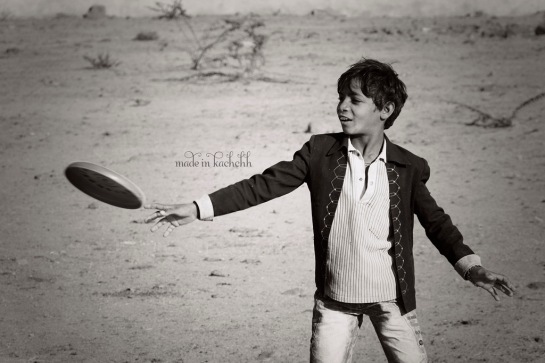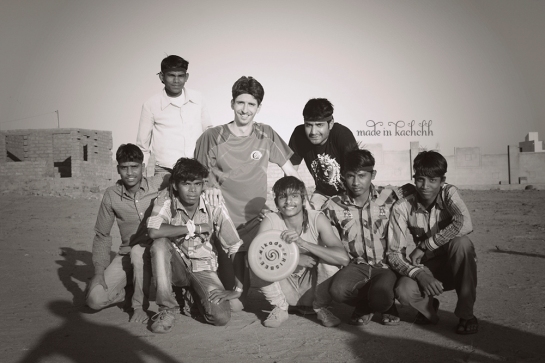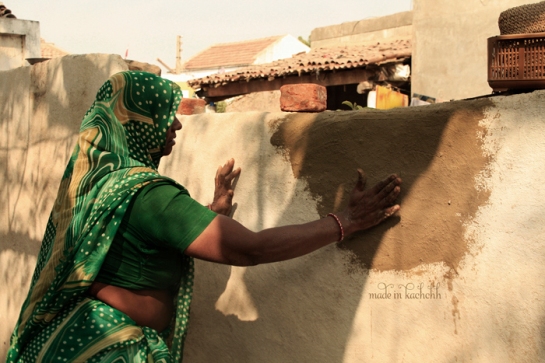When we arrived in Ajrakhpur, Hojefa was not home … so we sat in front of his workshop. After the earthquake in 2001, a large number of workshops were built in the village to encourage the artisans to keep their craft of ‘Block Printing’, alive. They all look a bit similar : a concrete structure, flat roofs, a small sitting space in front of the entrance door and a patchwork of randomly spread colours on either side of the entrance wall, memories left by the buckets of dyes which were carried hurriedly in and out the building. But Hojefa’s entrance is different… no colours… but a layer of sawdust spread out on the ground as if an ocean of wood shaving was waiting inside for somebody to open and flow towards us. Hojefa is not a blockprinter, he is the one that makes the blocks for them! And he is the only one in Kachchh. His brother, working next door, explains that Hojefa has gone to Bhuj and will be back soon. He opens the door for us, inviting us to come and sit inside. We are not welcomed by a growling wave of sawdust as I expected but by a sea of saws, wood pieces, cutters, plyers, drills, punch, lime, hammer and a multitude of unknown objects scattered all around the place.The first thought that comes to my mind is “How can u work in this chaos!” And then Hojefa arrives. He quickly cleans a small low table to make me sit. He himself sits on the floor, fitting his whole body in a square foot of cleared space. His smile makes you forget everything that is around…he is an emperor and this is his kingdom. Let’s begin!? 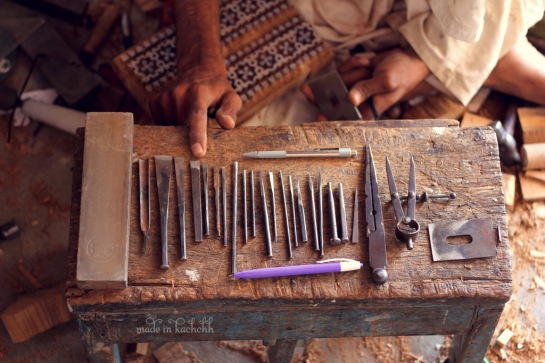
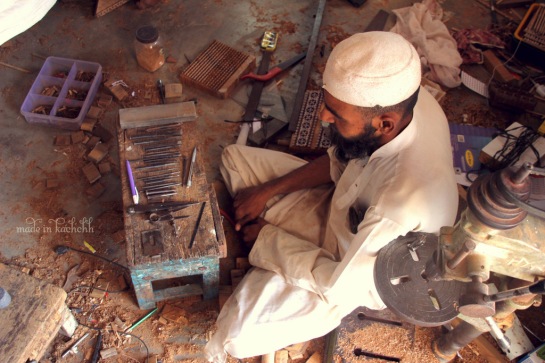 He gathers all the tools that he needs in a few seconds and spreads them on a small foot stool that he uses as a workbench. He explains that this stool was made by his dad, it has 2 small compartments to keep the smallest wood cutters and punch. He then takes position behind his pillar drill and starts showing us how to shape a block.
He gathers all the tools that he needs in a few seconds and spreads them on a small foot stool that he uses as a workbench. He explains that this stool was made by his dad, it has 2 small compartments to keep the smallest wood cutters and punch. He then takes position behind his pillar drill and starts showing us how to shape a block. 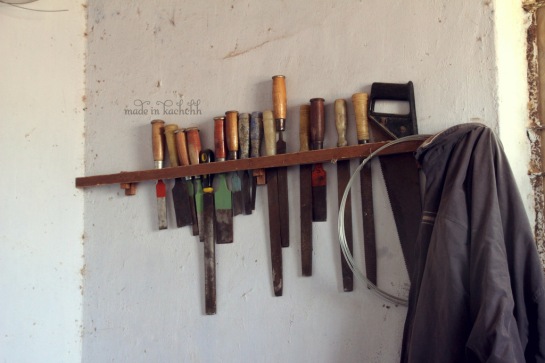 We are all fascinated by the speed at which he moves the block to carve the shape of the design he has previously marked on the piece of wood. When they were not using a power drill, they used to spend up to 6 days to finish one block. Now, depending on the complexity of the design, it can take a few hours to a day.
We are all fascinated by the speed at which he moves the block to carve the shape of the design he has previously marked on the piece of wood. When they were not using a power drill, they used to spend up to 6 days to finish one block. Now, depending on the complexity of the design, it can take a few hours to a day. 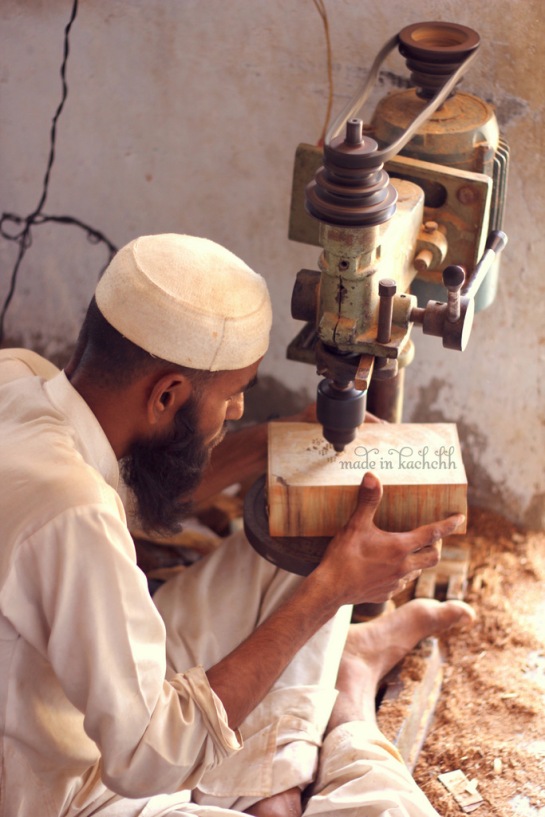

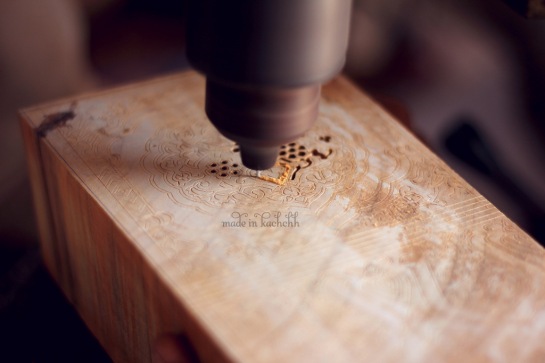
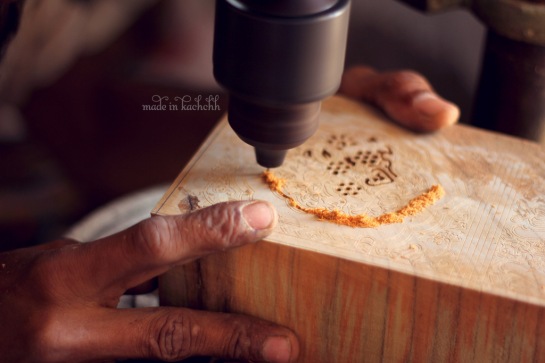 He still wants to show us how a block is made completely by hand and makes us go through the whole process. Marking. Shaping. Drilling. Cutting. Carving and Cleaning.
He still wants to show us how a block is made completely by hand and makes us go through the whole process. Marking. Shaping. Drilling. Cutting. Carving and Cleaning. 

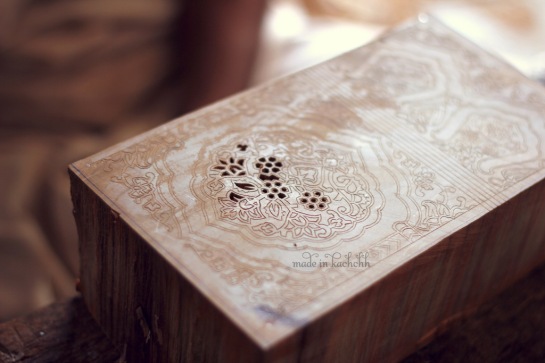 The intricacy of the design is impressive and his precision and patience to transform it into a block is mind blowing. The shape that he is making will then be used to print thousands of meters of cloth, a single mistake will also be visible that many times… He is one more essential link in this fascinating chain of human skills that is block-printing.
The intricacy of the design is impressive and his precision and patience to transform it into a block is mind blowing. The shape that he is making will then be used to print thousands of meters of cloth, a single mistake will also be visible that many times… He is one more essential link in this fascinating chain of human skills that is block-printing. 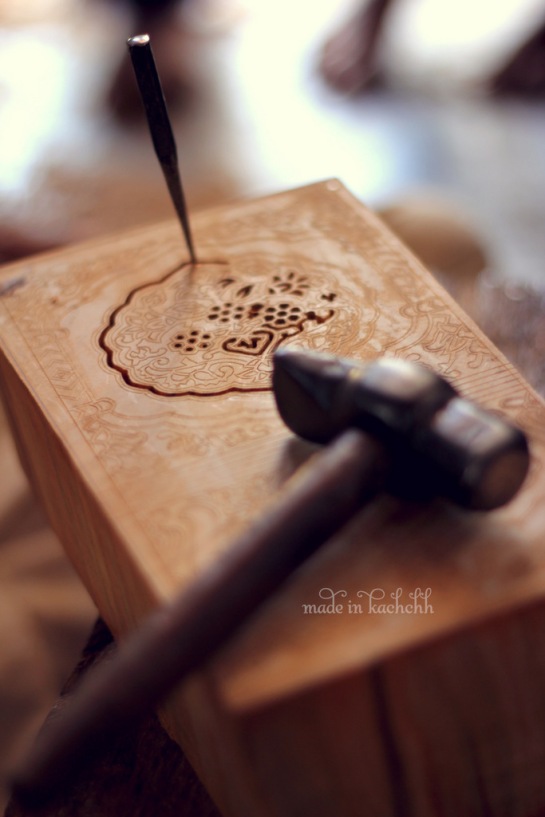
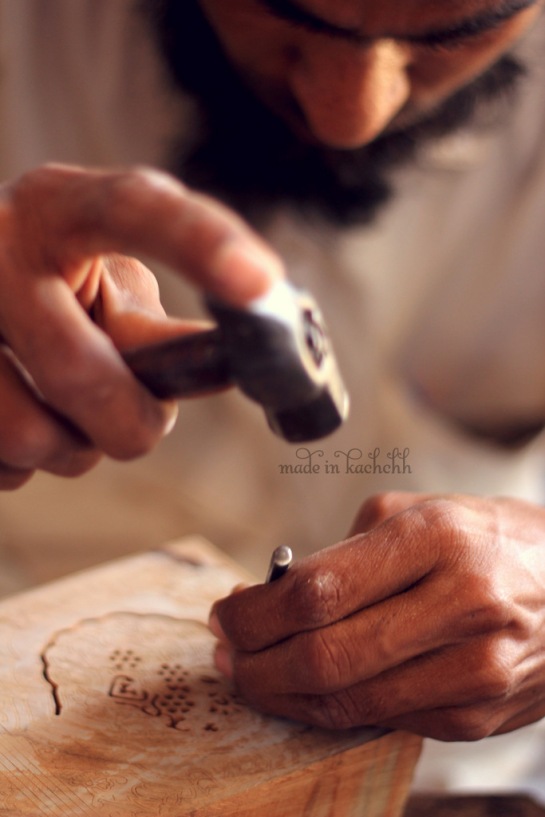
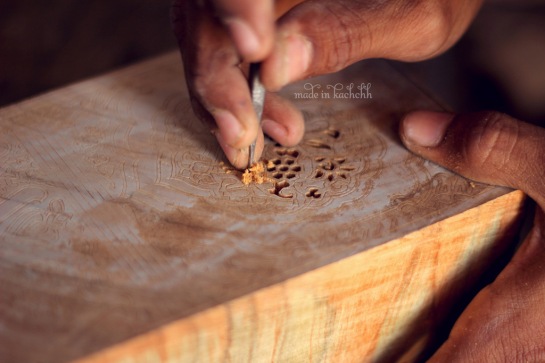
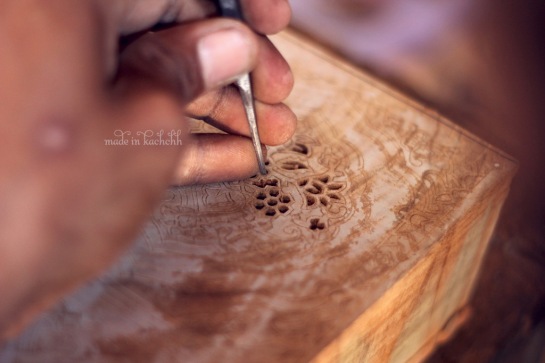 As I pick up a paper with a beautiful ajrakh pattern handdrawn on it, covered with sawdust, swimming in this workshop, I ask him, “Hosafabhai, why aren’t there more block makers like you in Kachchh?”
As I pick up a paper with a beautiful ajrakh pattern handdrawn on it, covered with sawdust, swimming in this workshop, I ask him, “Hosafabhai, why aren’t there more block makers like you in Kachchh?” 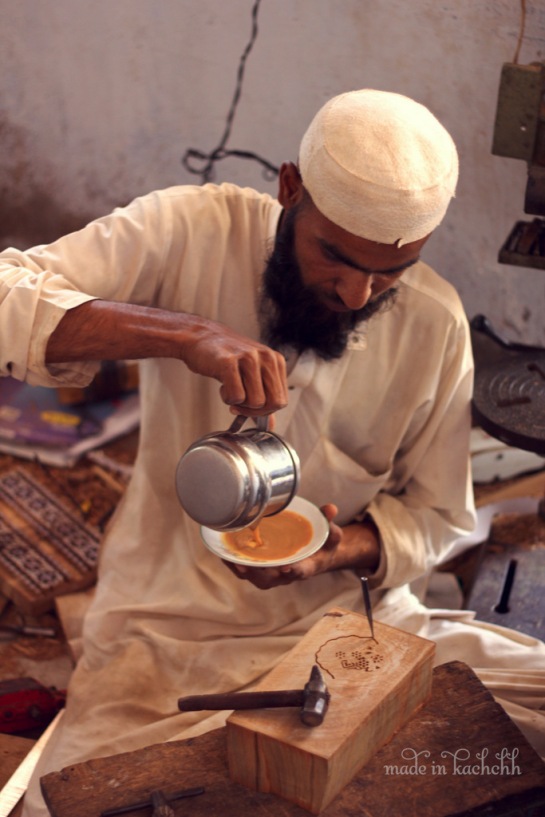 He hands me a saucer of chai and says, ” Because you have to sit. You have to sit the whole day. Sit sit sit. Be patient. and concentrate. Sit. It is true that many people know how to make blocks. They have the skill. But they do not want to sit. You have to be passionate and you just have to sit.”
He hands me a saucer of chai and says, ” Because you have to sit. You have to sit the whole day. Sit sit sit. Be patient. and concentrate. Sit. It is true that many people know how to make blocks. They have the skill. But they do not want to sit. You have to be passionate and you just have to sit.”  He spends nearly 2 hours sitting with us, replying to our questions and showing us all the steps of his work. During this entire time I didn’t once think of the chaos that was surrounding us, I only saw his passion, his dexterity, his smile and the beautiful perfection of his work.
He spends nearly 2 hours sitting with us, replying to our questions and showing us all the steps of his work. During this entire time I didn’t once think of the chaos that was surrounding us, I only saw his passion, his dexterity, his smile and the beautiful perfection of his work.
Author Archives: Jérémie
Ultimate Frisbee as a Weapon of Mass Collaboration
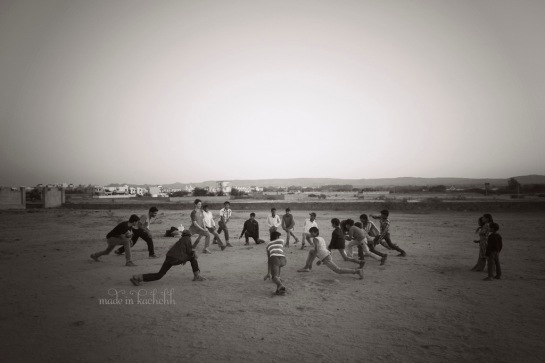 It has now been three months since we started a small team of Ultimate Frisbee at Bhuj in Kachchh, Gujarat with young people from the city between 13 to 19 years. Despite their unshakeable passion for Cricket, they were quickly captured by this game.
It has now been three months since we started a small team of Ultimate Frisbee at Bhuj in Kachchh, Gujarat with young people from the city between 13 to 19 years. Despite their unshakeable passion for Cricket, they were quickly captured by this game.
We are; Siddharth (a young architect from Mumbai and working in Bhuj for the past 2 years), Satish (an engineer who fled from the madness of IT companies in Mumbai to start a new life here), Matt (American, very attached to Kutch after a year of volunteering in a local NGO in Bhuj and is now back for a few months) and me (Jeremie).
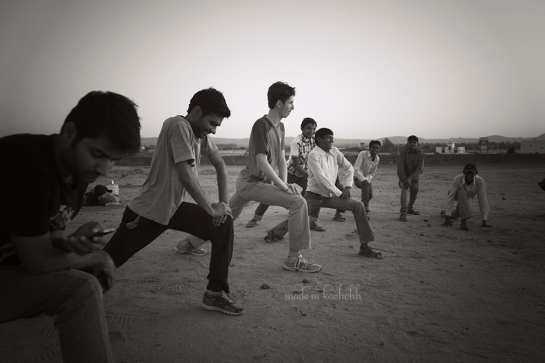 I am not going to hide that one of the reasons for our motivation to make this project happen is the need to MOVE, so we can play a sport and get some physical exercise. However, this experience has gone far beyond the simple ” Sunday Afternoon Sports ” and turned into a true training ground for young people like us.
I am not going to hide that one of the reasons for our motivation to make this project happen is the need to MOVE, so we can play a sport and get some physical exercise. However, this experience has gone far beyond the simple ” Sunday Afternoon Sports ” and turned into a true training ground for young people like us.
I don’t think I can make a better definition for you than wikipedia :
Ultimate is a team sport played with a flying disc. The objective of the game is to score points by passing the disc to a player in the opposing end zone, similar to an end zone in American football or the in-goal area in rugby. Players may not run with the disc, and must keep a pivot while holding the disc.
Basically it is a mix of rugby (there goes the ball until it exceeds the line of opposing camps) and Basketball: no contact and no right to proceed with the frisbee in hand … Another important detail: there is no referee, it is “self-balance”!
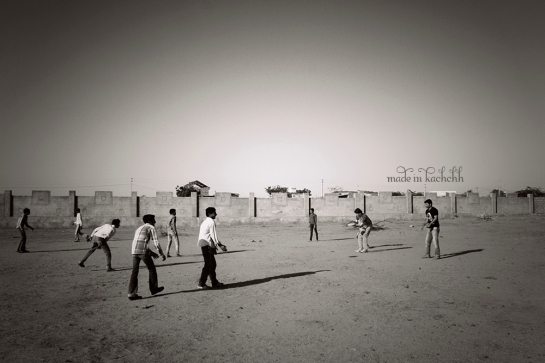 Maybe you begin to understand the title of the article and the obligation to “really” play as a team since a player cannot do anything alone!
Maybe you begin to understand the title of the article and the obligation to “really” play as a team since a player cannot do anything alone!
Young people with whom we play, as I said earlier, are fans of cricket. For those who do not know the rules of cricket I let you discover them here because this is not really the point of this article, but it is important to have an idea of what it is to understand the “cooperative” nature of this game as compared to Ultimate Cricket that is based so much on individual performances.
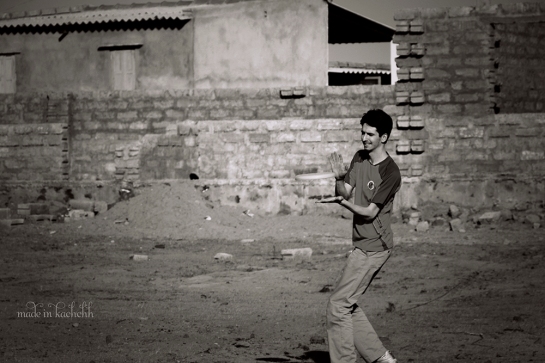 During the first sessions, young people had no idea what it was like to play “together.” They spent their time yelling and trying to find someone responsible for errors.
During the first sessions, young people had no idea what it was like to play “together.” They spent their time yelling and trying to find someone responsible for errors.
At the first meeting they insisted that they be given a frisbee “to train” during the week.
The transition between the first and the second session was dramatic! They realized that the only way to score a point is to observe colleagues, to position depending on the game and other players, to involve everyone. And more importantly, they realized that if one of them had “technical” difficulties, it was their responsibility to help.
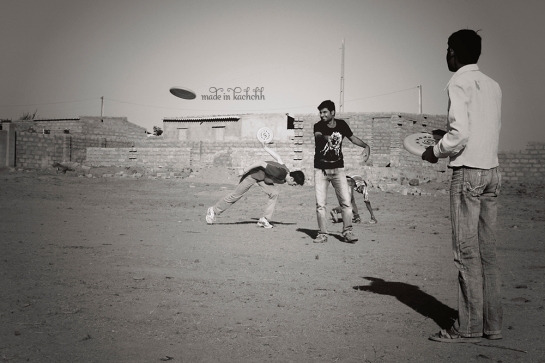 It is now almost three months we started this and frankly, it’s been fantastic! The kids really hung in there and are even insisting that we now play 3-4 times a week! It is not easy to keep pace!
It is now almost three months we started this and frankly, it’s been fantastic! The kids really hung in there and are even insisting that we now play 3-4 times a week! It is not easy to keep pace!
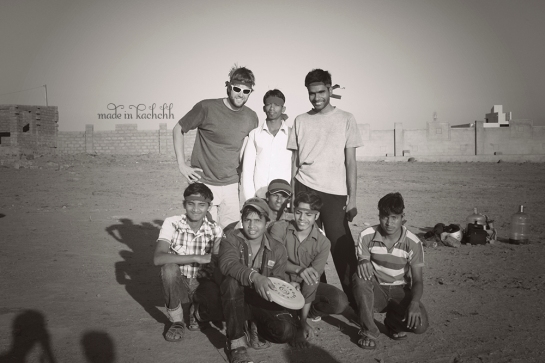 Our next step: an “inter-city” match with teams from Mumbai and Ahmedabad. We will tell you soon!
Our next step: an “inter-city” match with teams from Mumbai and Ahmedabad. We will tell you soon!
The challenge of eating ‘less’ but ‘better’
A visit to a village of weavers, this sunny sunday morning, made me think a lot and I want to share this experience with you. Bhujodi, a small village about ten kilometers east of Bhuj is inhabited by several craftsmen who specialize in hand-loom weaving. Besides the fact that artisans welcomed us to their homes as if we were family, they shared their knowledge with passion and without a second thought about selling anything to us.
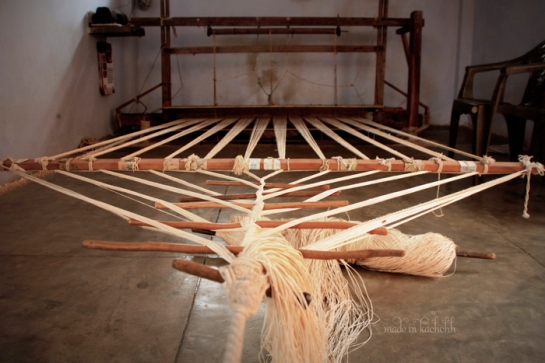 First we meet Narayan-bhai and his son. They specialize in the manufacture of woollen carpets. Today it is a bit special, they are preparing for Diwali, the Indian New Year, so are coating the walls of their home with a mixture of mud, lime and cow-dung.
First we meet Narayan-bhai and his son. They specialize in the manufacture of woollen carpets. Today it is a bit special, they are preparing for Diwali, the Indian New Year, so are coating the walls of their home with a mixture of mud, lime and cow-dung.
However seeing our excitement to watch the looms work, they settle down at their looms and start weaving a carpet. Although I’ve seen weaving work before, I am fascinated! Beyond the technical moves that are impressive, the complexity and beauty of the machine leaves me speechless. All these lines, these regular movements, these colors … create an atmosphere that is truly mesmerizing!
They have 2 looms, fully manual. The one that Naryanbhai uses
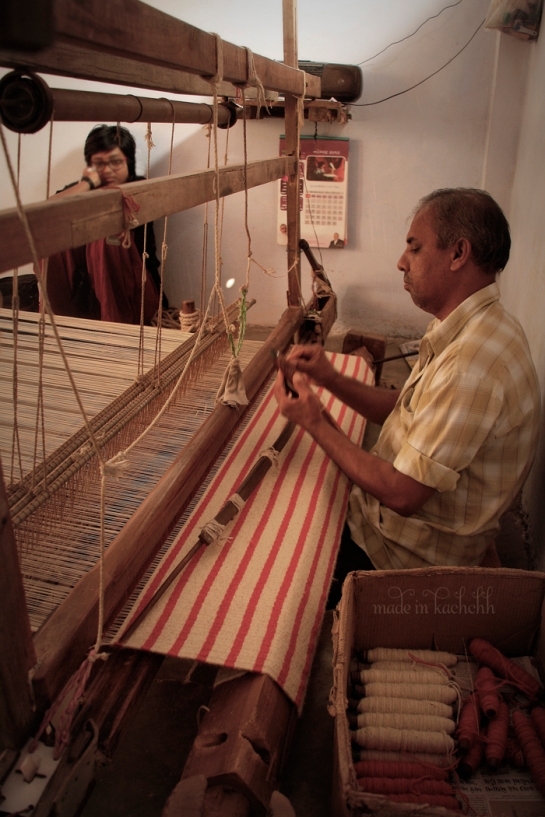 and the other handled by his son:
and the other handled by his son:
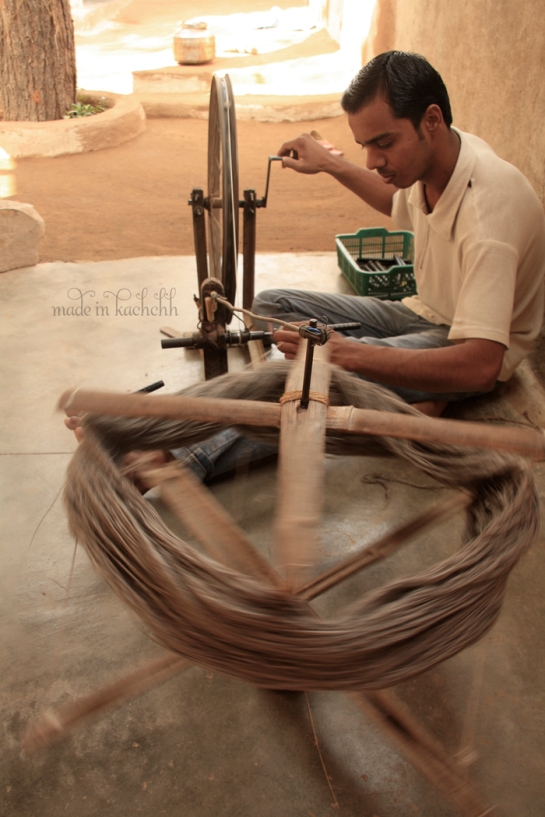 My wife and I sit there for a long time just watching them work. Most of their production is for a client from Finland! They take about 1 day to make 1 carpet.
My wife and I sit there for a long time just watching them work. Most of their production is for a client from Finland! They take about 1 day to make 1 carpet.
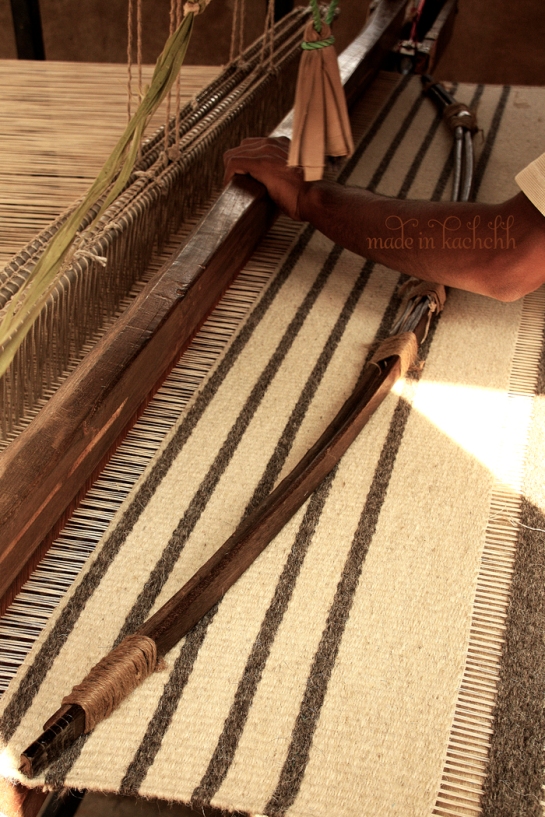 They are proud to show that they have designed a carpet with three different types of wool: camel, black sheep and white sheep.
They are proud to show that they have designed a carpet with three different types of wool: camel, black sheep and white sheep.
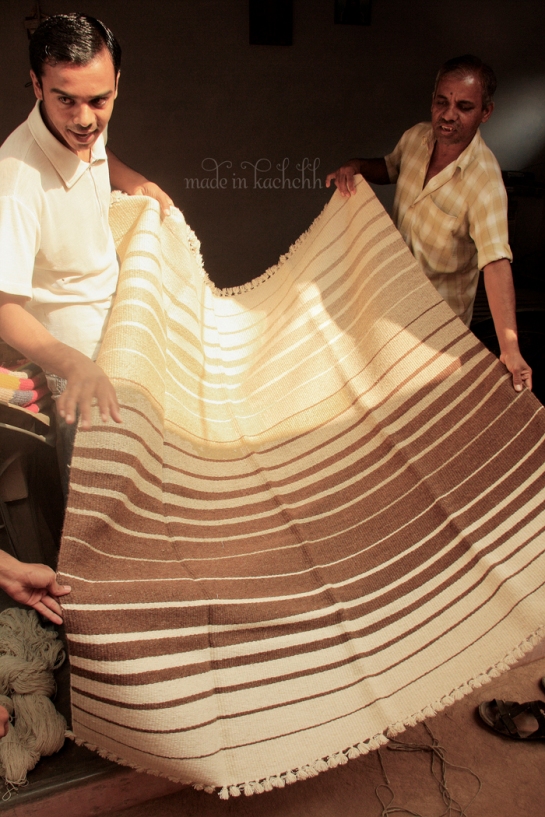 They say they love the creative side of their craft, but do not have enough time to truly experiment since they need to produce carpets for the Finnish which are large orders and are always the same : gray and white…”european tastes!” they say.
They say they love the creative side of their craft, but do not have enough time to truly experiment since they need to produce carpets for the Finnish which are large orders and are always the same : gray and white…”european tastes!” they say.
And then there is Purushothambhai. If you can read the name correctly the first time you win a silk shawl 🙂 We had not even planned to visit his home, he catches us on the streets and says “come and see, I have something to show you.”
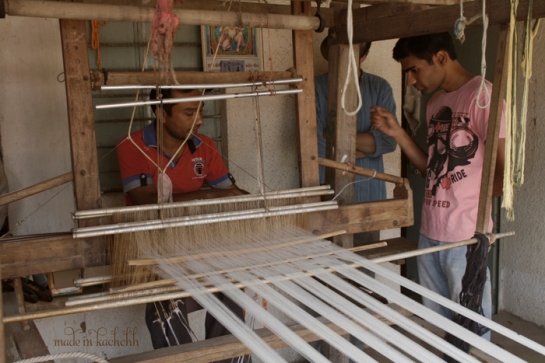 He begins by showing us a series of very finely woven shawls with a mixture of silk and cotton, then take us to his loom. It is much narrower than Naryanbhai because it is used to make scarves and shawls but it is equally impressive.
He begins by showing us a series of very finely woven shawls with a mixture of silk and cotton, then take us to his loom. It is much narrower than Naryanbhai because it is used to make scarves and shawls but it is equally impressive.
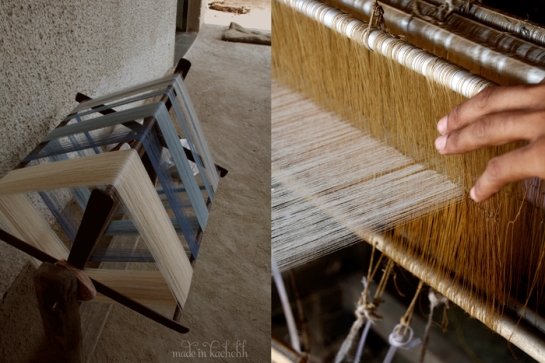 The thread is much thinner, and the weaving takes longer. Depending on the type of pattern, a piece can take up to 1 month. The method for doing this kind of pattern is inexplicable in writing, it has been a good half an hour to figure out how he is doing it! Purushothambhai is first and foremost an artist, he creates his own designs, his own forms … He sells his works everywhere in India, at exhibitions and events related to crafts.
The thread is much thinner, and the weaving takes longer. Depending on the type of pattern, a piece can take up to 1 month. The method for doing this kind of pattern is inexplicable in writing, it has been a good half an hour to figure out how he is doing it! Purushothambhai is first and foremost an artist, he creates his own designs, his own forms … He sells his works everywhere in India, at exhibitions and events related to crafts.
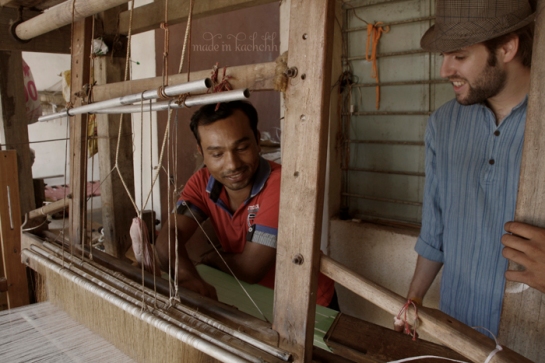 He tells us this moving story of how he once set off to create his “best” piece, he had already given three months of hardwork into it and while it was still on the loom and nearly complete, an insect ate into it. This piece hence will never get sold. But will remain with him to tell his story.
He tells us this moving story of how he once set off to create his “best” piece, he had already given three months of hardwork into it and while it was still on the loom and nearly complete, an insect ate into it. This piece hence will never get sold. But will remain with him to tell his story.
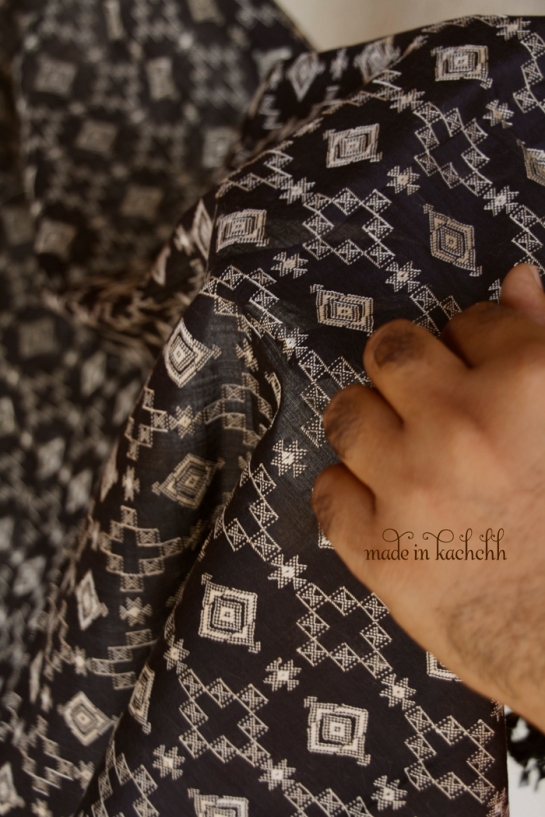 To be able to feel the connection between knowledge and the product is really a unique experience, it gives a new perspective on the value of things.
To be able to feel the connection between knowledge and the product is really a unique experience, it gives a new perspective on the value of things.
“The industrial era” helped us make a bunch of objects accessible in large numbers and at a price much more affordable than products that are “handmade”. This is what allows us to not have to save for two months to buy a pair of trousers, that I personally find quite handy … However, this “progress” has totally engulfed our concept of the “value” of things.
There is little or no information on the conditions under which the products we use are made, by whom, with what, with what impact on the environment and on society more generally. Take the time to take this step to “understand” a product, to look at it differently and go back again to the challenge of eating “less” but “better”.


